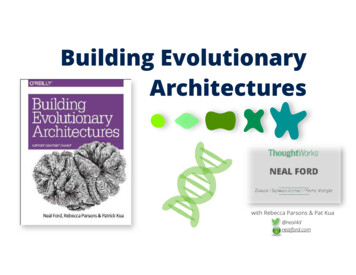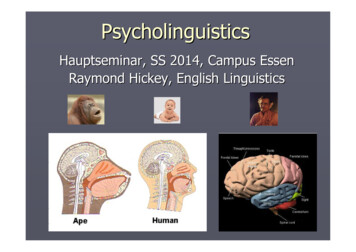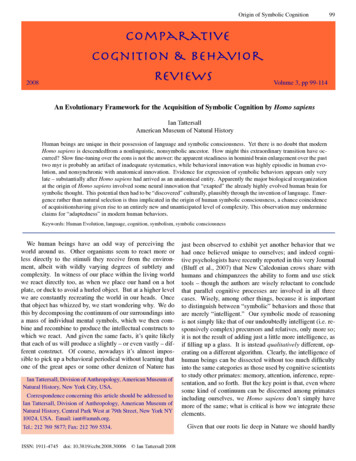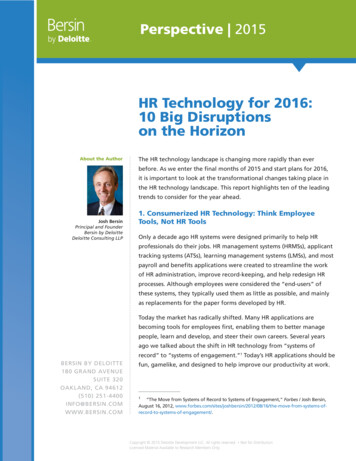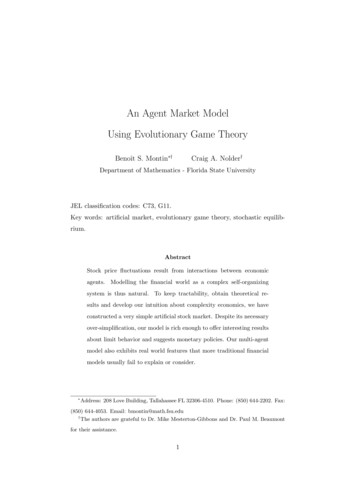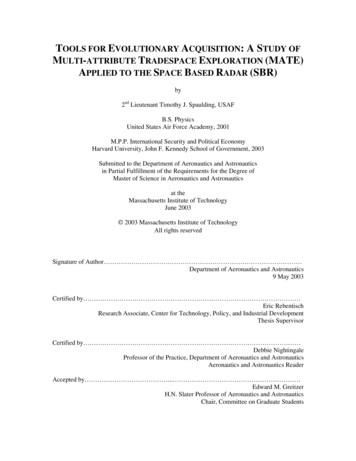
Transcription
TOOLS FOR EVOLUTIONARY ACQUISITION: A STUDY OFMULTI-ATTRIBUTE TRADESPACE EXPLORATION (MATE)APPLIED TO THE SPACE BASED RADAR (SBR)by2nd Lieutenant Timothy J. Spaulding, USAFB.S. PhysicsUnited States Air Force Academy, 2001M.P.P. International Security and Political EconomyHarvard University, John F. Kennedy School of Government, 2003Submitted to the Department of Aeronautics and Astronauticsin Partial Fulfillment of the Requirements for the Degree ofMaster of Science in Aeronautics and Astronauticsat theMassachusetts Institute of TechnologyJune 2003 2003 Massachusetts Institute of TechnologyAll rights reservedSignature of Author Department of Aeronautics and Astronautics9 May 2003Certified by Eric RebentischResearch Associate, Center for Technology, Policy, and Industrial DevelopmentThesis SupervisorCertified by Debbie NightingaleProfessor of the Practice, Department of Aeronautics and AstronauticsAeronautics and Astronautics ReaderAccepted by . Edward M. GreitzerH.N. Slater Professor of Aeronautics and AstronauticsChair, Committee on Graduate Students
Opinions, conclusions, and recommendations expressed or implied within are solelythose of the author and do not necessarily represent the views of the Air Education andTraining Command, the United States Air Force, the Department of Defense, or any otherUS government agency.2
TOOLS FOR EVOLUTIONARY ACQUISITION: A STUDY OFMULTI-ATTRIBUTE TRADESPACE EXPLORATION (MATE)APPLIED TO THE SPACE BASED RADAR (SBR)by2nd Lieutenant Timothy J. Spaulding, USAFSubmitted to the Department of Aeronautics and Astronauticsin Partial Fulfillment of the Requirements for the Degree ofMaster of Science in Aeronautics and AstronauticsABSTRACTThe Multi-Attribute Tradespace Exploration (MATE) process was applied to theSpace Based Radar (SBR), a space system under study by the United States Air Force. Asystem-level model of possible SBR architectures was created using data and analysisfrom previous high-level studies. Competing designs were evaluated through MATE’suniversal utility metric.The MATE model was qualitatively compared against a high-level design studyand MATE’s advantages were noted, specifically its ability to trace modelingassumptions and present a holistic view of the space of competing designs. Aquantitative comparison revealed significant differences between MATE’s recommendedsystem design and that of the comparison high-level study.The potential for a simplification of the MATE method was explored through theuse of several approximations to revealed user preferences. Comparisons were madethrough both a proportional utility loss metric and a general Spearman’s Rho rank ordercorrelation. Using these measures it was shown that while a linear or subjectiveapproximation to utility curves resulted in excessive errors, and approximation toweighting relationships did not.Finally, MATE’s potential applicability to the Air Force acquisition process wasstudied. In general MATE was shown to be useful to any acquisition effort that derivesits benefit from a networked approach and is of sufficient technical complexity as tomake tradeoff decisions opaque to casual analysis. Specifically, MATE was shown to beuseful in the analysis of alternatives process as well as an aid to early milestone sourcingdecisions.Thesis supervisor: Dr. Eric RebentischTitle: Research Associate, Center for Technology, Policy, and Industrial Development3
BIOGRAHICAL NOTETim Spaulding was born on June 14, 1979 in Stillwater, Minnesota. Movingaround while young, Tim grew up mainly in Centennial, Colorado, a suburb south ofDenver. It was there that he was first exposed to the Air Force Academy, where heenrolled in June 1997 after graduating from Aledo High School outside of Fort Worth,Texas. He earned his commission as a 2nd Lieutenant upon graduating from the Academyin May, 2001.As a cadet, Tim majored in physics and minored in math, specializing in problemsinvolving the intersection between wireless communication and space physics. Namedthe 2001 outstanding physics major, Tim was also selected in 2000 for the TrumanScholarship, a nationwide graduate scholarship given to students who are pursuingcareers in public service.While not thinking about physics, Tim was a cadet instructor at the Academy’sth94 Flying Training Squadron, teaching underclass cadets how to fly the Schweitzer 2-33sailplane. In the fall of 2000, he served as the Wing Commander of the Air ForceAcademy’s 4000 member cadet wing—the top cadet leadership position at the Academy.After graduating, Tim earned his private pilot’s license before beginning study fora Master’s in Public Policy degree at Harvard University’s Kennedy School ofGovernment where he focused on national and international security studies. While astudent at the Kennedy School Tim also took classes at MIT, following the example ofrecent Academy graduate Nathan Diller. After splitting his summer between an internshipat MIT’s Lincoln Lab and a position with the Air Force Scientific Advisory board, Timwas offered a research assistantship with MIT’s Lean Aerospace Initiative. Working inthis capacity, he was accepted as a Master of Science candidate in the Aeronautics andAstronautics department at MIT the next semester.The Air Force is the common thread between Tim’s research at Harvard andMIT—specifically, the Air Force’s efforts to embrace and implement a strategy of“evolutionary development.” At the Kennedy School Tim investigated the problems ofbudgeting for such a development strategy, while at MIT he investigated how tools ofsystems engineering could be harnessed for the same efforts.Before graduating from Harvard and MIT, Tim will do the one thing that can topboth—get married to Ms. Dorothy Ann Mackay, whom he was introduced to while acadet. After their wedding on May 31st 2003, Tim and Dori are moving to Sheppard AirForce Base in Wichita Falls, Texas where Dori will pursue her teacher’s certificationwhile Tim attends Euro-NATO Joint Jet Pilot Training.4
ACKNOWLEDGEMENTSOthers’ contributions to my research effort have been both varied and extensive.What follows is only a partial list of the support I have received—I offer my deepestapologies to anyone not mentioned here.My first thanks go to the Lean Aerospace Initiative, whose support in officespace, technical resources, and financial assistance were essential to the completion ofthis thesis. LAI was not only generous in this support, but was also willing to extend itbefore I was officially accepted as an MIT student.Dr. Eric Rebentisch of LAI has been unwavering in his support for me and myresearch, despite that fact that his plate was already full before he suddenly found himselfmentoring yet another student. His efforts on behalf of all of his students at LAI havebeen exemplary.The ACE group at LAI has been an invaluable source of feedback and discussion.Jason Derleth, Bobak Ferdowsi, and Chris Roberts made contributions to understandingand development that are evident throughout the research. Nirav Shah lent his never-tobe-underestimated technical abilities to my efforts. It is likely that I would have been indire straits without his considerable and timely assistance. Finally, I am indebted toAdam Ross and Nathan Diller, whose visions of MATE have provided fertile ground formine (and many others’) research efforts. Furthermore, Nathan’s trailblazing effortsmeant that my path through Harvard and MIT was far smoother than it would have beenotherwise.At Lincoln Lab I am indebted to Dr. Joe Chapa, who was willing to take me onfor a summer internship. His broad experience in engineering and Air Force programmanagement gave me a greater perspective on my efforts on both lines of research. Mr.Bob Coury’s help was also invaluable. His willingness to both share his RPAT softwaretool and provide support for its use was remarkable and critical to my efforts. I am alsograteful to Mr. Larry Tonneson for his willingness to take utility interviews and develop aset of system attributes for the Space Based Radar. Dr. Tony Phillip and Mr. RobertHarvey also provided key pieces of information for the construction of the MATE model.My Lincoln Lab internship experience was filled with these and many others whoseprofessionalism and dedication to the pursuit of knowledge led them to assist me in anumber of ways.My thanks also go to Dr. Ray Sedwick, whose expertise in space systems helpedcomplete the final parts of the radar coverage model. Also, I am grateful for the teachingteam of Dr. Joyce Warmkessel, Dr. Hugh McManus, and Dr. Daniel Hastings, whoseleadership of the 16.89 Space Systems Design course provided me the detailedexperience to embark on a MATE analysis of the Space Based Radar.None of these pages would have been written were it not for Dr. JoyceWarmkessel, whose vision permeates my and many others’ work at MIT. My debt to herguidance is unique since it was her personal efforts that brought me to MIT, found me ahome at LAI, and formed the very basis, direction, and goals of my research. Even while5
falling ill, Joyce was personally dedicated to seeing that I received the support anddirection that I needed. Joyce, you are sorely missed.The support I received from the Air Force was crucial as well. Captain MelissaFlattery initially enabled me to branch my efforts out to MIT, and 1st Lieutenant AngelaBjorge continued this support through her professional, courteous, and rapidly responsiveadministrative help. I am also in the debt of Captain Kent Broome of the Air ForceScientific Advisory Board, who not only enabled me to gain a world of experience whileworking with him at the board, but also helped me get into MIT.My family’s support during my time in Cambridge has been unconditional, evenif it meant that phone calls and e-mails home were sometimes few and far between. At adeeper level, I am eternally grateful for having grown up in a home with parents wholoved both each other and their children, and who dedicated themselves to seeing themsucceed. I attribute any success I have had in life to having been raised in such anenvironment.Finally, my sincere thanks go to the person who has the most direct and personalexperiences with the downsides of a busy research agenda—my soon-to-be wife Dori.Dori not only happily coped with a fiancé who had two demanding mistresses named“Harvard” and “MIT,” but performed admirable duty as both travel agent and taxiservice. As if this weren’t enough, she gladly submitted to being a test subject for aMATE analysis and happily proofread an untold number of arcane policy memos andterm papers, pointing out and removing superfluous commas without a word ofcomplaint. Dori kept me on track and in high spirits even when I was desperately tryingto take myself too seriously. Thank you, Dori, for your support andencouragement—after this, pilot training should look like a vacation!6
For Joyce7
TABLE OF FIGURESFIGURE 1: WHY CHANGE IS NEEDED (LITTLE, 2000) . 14FIGURE 2: THE MATE PROCESS . 21FIGURE 3: MULTIPLICATIVE MULTI-ATTRIBUTE UTILITY FUNCTION (KEENEY, 1976) . 24FIGURE 4: LOTTERY EQUIVALENT PROBABILITY . 31FIGURE 5: CORNER POINT INTERVIEW . 32FIGURE 6: SBR ATTRIBUTES AND RANGES . 41FIGURE 7: QFD FOR SBR MODEL . 44FIGURE 8: PROPORTIONAL UTILITY LOSS FORMULA . 48FIGURE 9: SPEARMAN'S RHO FORMULA . 49FIGURE 10: SUMMER STUDY SELLER TEAM (SBR STAFF, LINCOLN LAB INTERNAL) . 56FIGURE 11: SUMMER STUDY BUYER TEAM (SBR STAFF, LINCOLN LAB INTERNAL). 57FIGURE 12: SUMMER STUDY SCHEDULE (TOP LEVEL SCHEDULE, LINCOLN LAB INTERNAL) . 59FIGURE 13: SUMMER STUDY USER NEEDS SPACE (LINCOLN LAB INTERNAL) . 60FIGURE 14: TRADESPACE USING MIST1 DATA . 64FIGURE 15: TRADESPACE USING MIST2 DATA . 64FIGURE 16: TRADESPACE USING HAND2 DATA . 65FIGURE 17: TRADESPACE USING LINEAR DATA . 65FIGURE 18: PARETO OPTIMAL ARCHITECTURES WITH MIST1 DATA. 67FIGURE 19: PARETO OPTIMAL ARCHITECTURES WITH MIST2 DATA. 68FIGURE 20: PARETO OPTIMAL ARCHITECTURES WITH HAND2 DATA. 69FIGURE 21: PARETO OPTIMAL ARCHITECTURES WITH LINEAR DATA . 70FIGURE 22: MIST2 TRADESPACE BY NUMBER OF SATELLITES . 71FIGURE 23: MIST2 TRADESPACE BY SCAN ANGLE (DEGREES AZIMUTH AND ELEVATION). 72FIGURE 24: MIST2 TRADESPACE BY TECHNOLOGY LEVEL . 73FIGURE 25: MIST2 TRADESPACE BY APERTURE SIZE . 74FIGURE 26: MIST2 TRADESPACE BY ORBIT ALTITUDE. 75FIGURE 27: LINCOLN LAB RECOMMENDATIONS IN MIST2 . 82FIGURE 28: WEIGHTING VALUES. 86FIGURE 29: PROPORTIONAL UTILITY LOSS (PUL) FOR ALTERNATE UTILITY SETS -- NO WEIGHTING . 87FIGURE 30: GRAPHICAL REPRESENTATION OF ERRORS FROM ELICITATION. 89FIGURE 31: PUL FOR ALTERNATE UTILITY SETS -- WITH WEIGHTED RANK ORDERING. 91FIGURE 32: PUL FROM DROPPING LEAST WEIGHTED . 92FIGURE 33: PUL FROM DROPPING MOST WEIGHTED . 93FIGURE 34: SPEARMAN'S RHO – NO WEIGHTING . 94FIGURE 35: SPEARMAN'S RHO – WITH RANK WEIGHTING . 96FIGURE 36: WEIGHTING VALUES, JPO FEEDBACK. 99FIGURE 37: COMMON PARETO-FRONT . 100FIGURE 38: COMMON PARETO FRONT GRAPHICALLY . 101FIGURE 39: UTILITY DATA . 110FIGURE 40: TRACKING AREA UTILITY CURVES . 111FIGURE 41: MINIMUM SPEED UTILITY CURVES. 112FIGURE 42: SAR AREA UTILITY CURVES. 112FIGURE 43: SAR RESOLUTION UTILITY CURVES . 113FIGURE 44: CROSS RANGE ACCURACY UTILITY CURVES . 113FIGURE 45: GAP TIME UTILITY CURVES. 114FIGURE 46: CENTER OF GRAVITY UTILITY CURVES . 114FIGURE 47: N 2 FOR SBR MODEL . 115FIGURE 48: SOFTWARE FLOW FOR SBR MODEL. 1168
TABLE OF CONTENTSABSTRACT. 3BIOGRAHICAL NOTE. 4ACKNOWLEDGEMENTS . 51. INTRODUCTION AND MOTIVATION. 111.1 EVOLUTIONARY ACQUISITION . 11Recent Acquisition Woes . 13Applicability of MATE. 15Further Reading . 161.2 SPACE BASED RADAR (SBR). 17Recent Studies. 182. LITERATURE REVIEW . 192.1 MATE . 19MATE History. 19MATE Process Overview. 21Research Question 1: . 252.2 OTHER METHODS SIMILAR TO MATE. 252.3 UTILITY THEORY ANALYSIS TOOLS. 28Research Question 2: . 332.4 SPACE BASED RADAR . 332.5 UTILITY THEORY WITH MULTIPLE DECISION MAKERS. 35Research Question 3: . 362.6 RESEARCH QUESTIONS . 373. RESEARCH METHODS. 393.1 MODEL DESCRIPTION . 39Attributes . 39Utility Curves . 42Design Variables . 42Model Assumptions. 443.2 QUESTION 1 . 463.3 QUESTION 2 . 473.4 QUESTION 3 . 514. DATA . 534.1 LINCOLN LABAORATORY PROCESS SUMMARY . 53Study Guidance. 53Study Process . 55Final Report . 614.2 TRADESPACES . 63Simple Tradespaces. 63Pareto Optimal Fronts . 66MIST2 Tradespace Broken Down by Design Vector. 715. ANALYSIS/DISCUSSION. 775.1 QUESTION 1 . 775.2 QUESTION 2 . 845.3 QUESTION 3 . 975.4 CONCLUSIONS . 1025.5 FURTHER RESEARCH . 1069
APPENDIX A: UTILITY DATA . 109A.1 SUMMARY . 110A.2 GRAPHS. 111APPENDIX B: MODEL CODE . 115B.1 SOFTWARE ARCHITECTURE. 115B.2 MODULE DESCRIPTIONS . 116Main Module . 116Mass and Power Module. 123Cost Module . 124RPAT and RPAT files module . 129Coverage and Time Optimization Modules. 131Radar Module. 134Utility Module. 136BIBLIOGRAPHY . 13910
1. Introduction and MotivationThe purpose of this thesis, broadly stated, is to further the state of knowledgeregarding the evolutionary acquisition of weapons systems for the United States AirForce. With that umbrella objective in mind, it attacks a much narrower field of studyrelated to the tools and processes that must be developed in order to enable theevolutionary acquisition strategy. Specifically, one such tool is examined: the MultiAttribute Tradespace Exploration (MATE) method developed at the MassachusettsInstitute of Technology by Adam Ross, Nathan Diller, Dr. Dan Hastings, Dr. JoyceWarmkessel, Dr. Hugh McManus, and others.The MATE tool is applied to a system currently under study by the AirForce—the Space Based Radar (SBR). SBR was one of the “pathfinder” programsidentified by the Air Force Acquisition Center of Excellence (ACE) office to be acandidate for evolutionary acquisition. As of this writing, the Space Based Radar is inthe “analysis of alternatives” stage of development, which means competing systemarchitectures are being evaluated, and the decision to go forward with full funding fordetailed design (milestone 0 in the Air Force Acquisitions parlance) has yet to be made.1.1 Evolutionary AcquisitionBefore endeavoring to discuss an evolutionary acquisition strategy, it is importantto clarify the terms used in the acquisition community, ensuring clear distinctions aredrawn between competing visions of ideal design processes:11
The standard model of acquisition is often called the “waterfall” or “top-down”method, and involves designing to a set of requirements defined as detailed design-workbegins. These requirements are rigid so that the designers know what capabilities theproduct will posses before it is finished, at least along the dimensions specified by therequirements document.An alternate means of acquisition is the “pre-planned product improvement” (P3I)method. This allows for scheduled product upgrades, which amount to improvements onthe original finished product. It is critical that these are usually small changes which canbe accomplished quickly and do not affect the overall design of the product in anysignificant way. An example is upgrading a car’s engine to a higher performance versionafter the car has already been designed and built. Another key characteristic of thismethod is that these changes are “pre-planned,” which means designers foresaw thechange when they designed the original.Evolutionary acquisitions (EA), by contrast to P3I, involves several full cycles ofthe traditional engineering process, each building on the last and providing someincremental capability. Products that function as networks are ready examples:evolutionary acquisition of a network of sensors might, in its first iteration of the designcycle consist of one sensor, placed in a strategic location. Further iterations wouldaugment this capability, adding more or better sensors to the network. These iterationsare commonly called “spirals” and are meant to be a full iteration of the engineeringprocesses of design, construction, and testing. Each cycle is intended to be performedfaster than the overall project would be, since each provides only an incrementalcapability.12
This concept, that engineering work might be better accomplished in short,repeating cycles, is not a new one—proponents of this method have been thinking andwriting for years. The initial and most successful applications of the method have been insoftware development (Highsmith, 2000).It is important here to note distinctions in the Air Force lexicon regarding thisprocess. In various fields of study, evolutionary acquisition is referred to as spiraldevelopment, spiral acquisition, and evolutionary development. For the purposes of theAir Force acquisitions community and this thesis, “evolutionary acquisition” refers to theconcept of developing a product in cycles rather than in
universal utility metric. The MATE model was qualitatively compared against a high-level design study and MATE's advantages were noted, specifically its ability to trace modeling assumptions and present a holistic view of the space of competing designs. A quantitative comparison revealed significant differences between MATE's recommended

